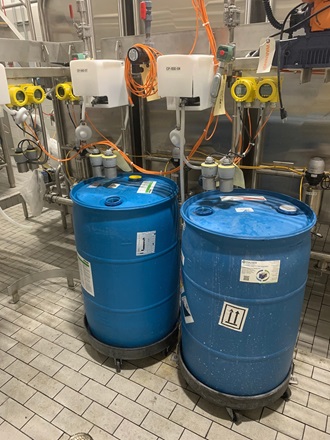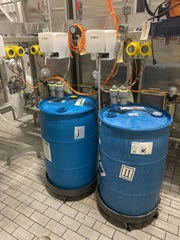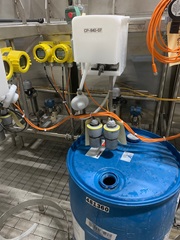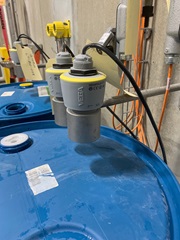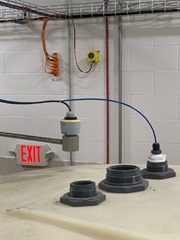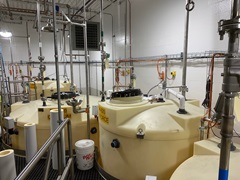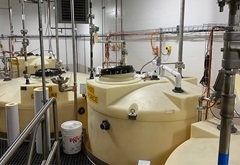How radar made the CIP process for butter so much better
For food and beverage facilities of all kinds, a hygienic process is synonymous with product quality and company reputation. That’s why a well-run clean-in-place (CIP) system is just as critical as the process it’s cleaning. For an Ohio dairy specializing in spreadable and stick butter, this couldn’t be truer.
This particular Ohio dairy is home to eleven production lines. Sanitizing and cleaning the equipment for each line is done with a CIP system using chemicals from exchangeable 55-gallon drums on rollers. There are a total of 21 drums in use at any given time, and all of them are scattered across the 140,000 square foot facility. Until recently, tracking chemical usage was a time-consuming and labor-intensive process.
A manual measurement and a manual process
Without any level measurement instrumentation, dairy employees were walking across the sprawling plant floor to complete regular sight checks of the chemical drums, record the measurements, and refill as needed. Visually checking each drum and constantly replenishing chemicals took a significant amount of time – time that could be spent on more important tasks. Plus, managing their chemical inventory like this made it difficult to track cleaning solution usage and fully understand its ROI.
The dairy was looking for a measurement solution that was compatible with the chemicals being used, easy to install, and simple to operate and maintain. After discussing these challenges and what they were trying to accomplish with the level and pressure measurement experts at VEGA, it was quickly determined a combination of radar level measurement sensors and display instrumentation would be just what this dairy needed.Non-contact measurement with 80 GHz radar
The dairy chose the VEGAPULS C 11, a wired radar level sensor capable of providing a continuous level measurement without touching the medium. This radar sensor uses 80 GHz technology, which delivers a measurement signal with a narrower focus, enabling the sensor to make measurements in small vessels without interference. Plus, with more of the radar’s signal reaching the product medium, it can measure nearly anything, despite its reflective properties.
Radar technology uses electromagnetic microwaves to make a measurement, which gives these sensors a couple of additional benefits when compared to other non-contact level measurement technologies. Radar signals are unaffected by fluctuating product properties like chemical vapors, which can sometimes disrupt other non-contact sensors’ signals. Plus, radar can measure through non-conductive materials like polyethylene and fiberglass, and this made installing these radars even easier on the mobile drums.
Each chemical drum was constantly on the move, being transferred from CIP stations where they were emptied to chemical day tanks where they were refilled. Since radar signals can measure through the polyethylene drums, installers simply mounted two radars above each station where employees parked the drums. Two radars were used for a redundant measurement, and even though they were mounted side-by-side, the electronics within each sensor eliminated any possibility of crosstalk, or measurement interference.
Completing the setup process was easy to accomplish with a smart device, the VEGA Tools App, and a Bluetooth connection. Radar sensors like the VEGAPULS C 11 can provide accurate level measurements in a wide range of applications regardless of temperature, pressure, and process conditions.
An automated measurement with an easy visual
In addition to incorporating the new level measurements into their control software, the dairy still wanted an easy way to see each chemical tank’s level measurement as personnel walked by. To accomplish this, a VEGADIS 82 display was paired with each VEGAPULS C 11 radar sensor. The VEGADIS 82 is a loop-powered external display complete with text and graphical indication.
In all, the dairy installed 42 radar sensors and 42 displays for the CIP chemical drums scattered across the facility and their larger day tanks used for refilling. The cost-effective solution enabled this dairy to free up time for employees to focus on other important tasks that had since been overlooked. Now, the dairy can accurately monitor and track chemical usage in one location, easily refill as needed, and if required, they can still manually check any drum levels on site.
Related products
Export this article
Download as PDFShare this article
Comments ({{comments.length}})
{{getCommentAuthor(comment, "Anonymous")}} {{comment.timestamp | date : "dd.MM.yyyy HH:mm" }}
{{comment.comment}}

